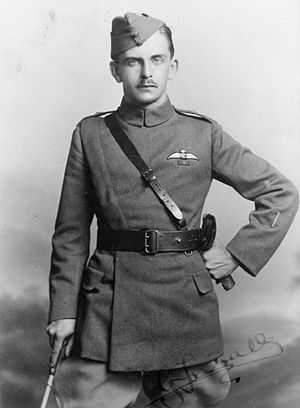Gilbert Insall
| Gilbert Stuart Martin Insall VC | |
|---|---|
 | |
| Born |
14 May 1894 Paris, France |
| Died |
17 February 1972 (aged 77) Scrooby, Nottinghamshire |
| Buried at |
Rose Hill Crematorium, Doncaster Headstone at Nocton Churchyard, Lincolnshire |
| Allegiance |
|
| Service/branch | |
| Years of service | 1915 - 1945 |
| Rank | Group Captain |
| Unit | No. 11 Squadron RFC |
| Battles/wars | |
| Awards | |
Gilbert Stuart Martin Insall VC MC (14 May 1894 – 17 February 1972) was a recipient of the Victoria Cross, the highest and most prestigious award for gallantry in the face of the enemy that can be awarded to British and Commonwealth forces.
World War I service
Insall was 21 years old, and a Second Lieutenant in the 11 Squadron, Royal Flying Corps during the First World War when he won the VC.[1]
On 7 November 1915 near Achiet-le-Grand, France, Second Lieutenant Insall, on patrol in Vickers F.B.5 Gunbus No. 5074 with 1st Class Air Mechanic T. H. Donald, engaged an Aviatik two-seater and forced the German pilot to make a rough landing in a plowed field. Seeing the air crew scramble out and prepare to fire, Insall dove to 500 ft and his gunner opened fire, whereupon the Germans fled. After dropping an incendiary bomb on the downed German aircraft, Insall flew through heavy fire at 2000 ft over enemy trenches. The Vickers' petrol tank was hit, but Insall brought the plane 500 yards back inside Allied lines for an emergency landing. Insall and Donald stayed by the Gunbus through a bombardment of about 150 shells while awaiting nightfall. After dark, they then set to work by torch light to salvage their plane. After they repaired the machine overnight, Insall flew them back to base at dawn.[2]
Insall could not personally receive his VC, however; he and Donald had fallen wounded into captivity on 14 December 1915 after engaging Hauptmann Martin Zander and his gunner. Insall escaped on his third try, on 28 August 1917, and made it home over the Dutch border on 6 September. He won the Military Cross in 1918. He returned to duty as the Flight Commander of "A" Flight, 51 Squadron, and would continue to serve his nation through 30 July 1945.[3]
Post World War I
Insall later achieved the rank of Group Captain.
After the War, Insall remained in the RAF. On a clear day in 1925, he spotted a strange formation of pits in the ground below him. He took a photograph, and from this one photograph came the rediscovery of the Bronze Age site now known as Woodhenge two miles from Stonehenge (Crawford, Air-Photography for Archaeologists 1929). In 1929 he similarly discovered Arminghall Henge.
Insall's headstone is in Nocton Churchyard, Lincolnshire. His Victoria Cross is displayed at the Royal Air Force Museum in Hendon.

Citation for the Victoria Cross
"For most conspicuous bravery, skill and determination, on 7 November 1915, in France. He was patrolling in a Vickers Fighting Machine, with First Class Air Mechanic T. H. Donald as gunner, when a German machine was sighted, pursued, and attacked near Achiet.
The German pilot led the Vickers machine over a rocket battery, but with great skill Lieutenant Insall dived and got to close range, when Donald fired a drum of cartridges into the German machine, stopping its engine. The German pilot then dived through a cloud, followed by Lieutenant Insall Fire was again opened, and the German machine was brought down heavily in a ploughed field 4 miles south-east of Arras.
On seeing the Germans scramble out of their machine and prepare to fire, Lieutenant Insall dived to 500 feet, thus enabling Donald to open heavy fire on them. The Germans then fled, one helping the other, who was apparently wounded. Other Germans then commenced heavy fire, but in spite of this, Lieutenant Insall turned again, and an incendiary bomb was dropped on the German machine, which was last seen wreathed in smoke. Lieutenant Insall then headed west in order to get back over the German trenches, but as he was at only 2,000 feet altitude he dived across them for greater speed, Donald firing into the trenches as he passed over.
The German fire, however, damaged the petrol tank, and, with great coolness, Lieutenant Insall landed under cover of a wood 500 yards inside our lines. The Germans fired some 150 shells at our machine on the ground, but without causing material damage. Much damage had, however, been caused by rifle fire, but during the night it was repaired behind screened lights, and at dawn Lieutenant Insall flew his machine home with First Class Air Mechanic T. H. Donald as a passenger."[4]
Sources of information
- ↑ Pusher Aces of World War 1'. p. 20.
- ↑ Pusher Aces of World War 1'. pp. 19–20.
- ↑ Pusher Aces of World War 1'. p. 20.
- ↑ (The London Gazette, 22 December 1915) http://www.london-gazette.co.uk/issues/29414/supplements/12797 Retrieved on 19May 2010.
References
- Monuments to Courage (David Harvey, 1999)
- The Register of the Victoria Cross (This England, 1997)
- VCs of the First World War - Air VCs (P G Cooksley, 1999)
External links
- Location of grave and VC medal (South Yorkshire)
- G.S.M. Insall
- Find-A-Grave
| ||||||||||||||||||